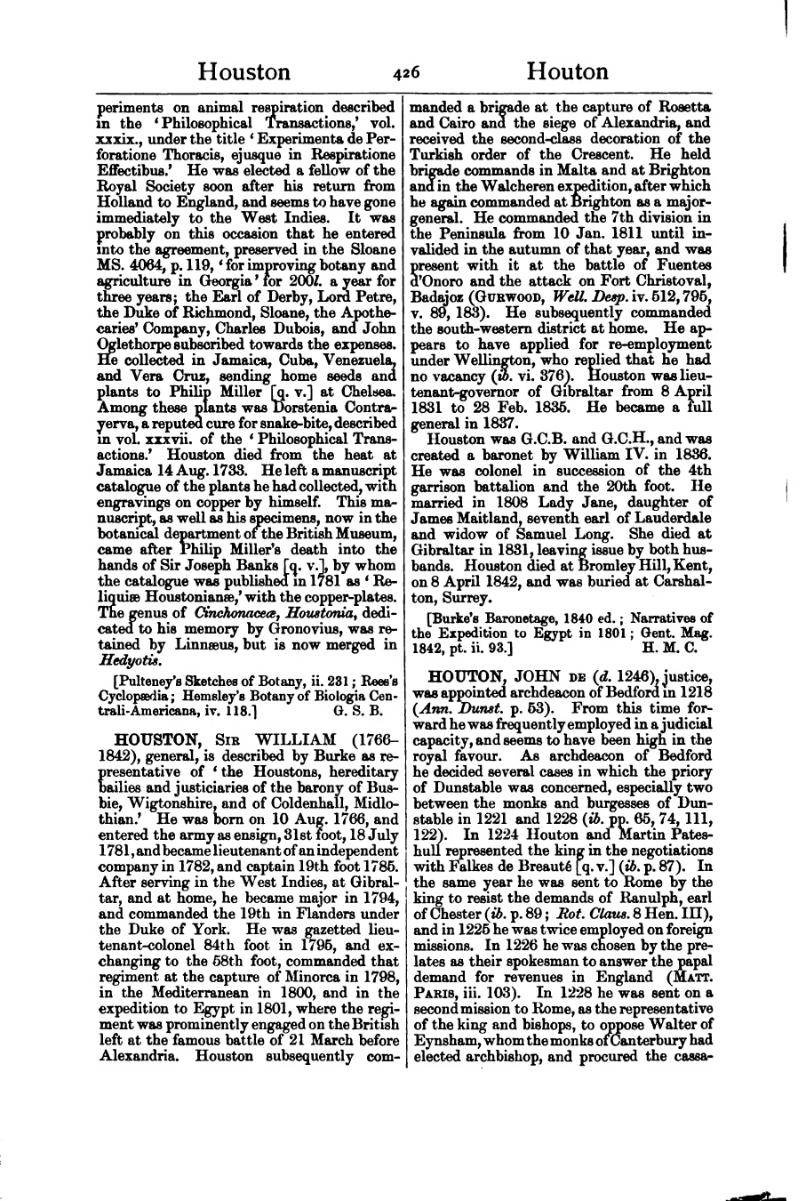periments on animal respiration described in the 'Philosophical Transactions,' vol. xxxix., under the title 'Experimenta de Perforatione Thoracia, ejusque in Respiratione Effectibus.' He was elected a fellow of the Royal Society soon after his return from Holland to England, and seems to have gone immediately to the West Indies. It was probably on this occasion that he entered into the agreement, preserved in the Sloane MS. 4064, p.119, 'for improving botany and agriculture in Georgia' for 200l. a year for three years; the Early of Derby, Lord Petre, the Duke of Richmond, Sloane, the Apothecaries' Company, Charles Dubois, and John Oglethopre subscribed towards the expenses. He collected in Jamaica, Cuba, Venezuela, and Vera Cruz, sending home seeds and plants to Philip Miller [q. v.] at Chelsea. Among these plants was Dorstenia Contrayerva, a reputed cure for snake-bite, described in vol. xxxvii. of the 'Philosophical Transactions.' Houston died from the heat at Jamaïca 14 Aug. 1733. He left a manuscript catalogue of the plants he had collected, with engravings on copper by himself. This manuscript, as well as his specimens, now in the botanical department of the British Museum, came after Philip Miller's death into the hands of Sir Joseph Banks [q.v.], by whom the catalogue was published in 1781 as 'Reliquiae Houstonianae' with the copper-plates. This genus of Cinchonaceae, Houstonia, dedicated to his memory by Gronovius, was retained by Linnaeus, but is now merged in Hedyotis.
[Pulteney's Sketches of Botany, ii.231 ; Reem's Cyclopaedia; Hemsley's Botany of Biologia Centrali-americana, iv. 118.]
HOUSTON, Sir WILLIAM (1766–1842), general, is described by Burke as representative of 'the Houstons, hereditary bailies and judiciaries of the barony of Busbie, Wigtonshire, and Coldenhall, Midlothian.' He was born on 10 Aug. 1766, and entered the army as ensign, 31st foot, 18 July 1781, and became lieutenant of an independent company in 1782, and captain 19th foot 1785. After service in the West Indies, at Gibraltar, and at home, he became major in 1794, and commanded the 19th in Flanders under the Duke of York. He was gazetted lieutenant-colonel 84th foot in 1795, and exchanging to the 58th foot, commanded that regiment at the capture of Minorca in 1798, in the Mediterranean in 1800, where the regiment was prominently engaged on the British left at the famous battle of 21 March before Alexandria. Houston subsequently commanded a brigade at the capture of Rosetta and Cairo and the siege of Alexandria, and received the second-class decoration of the Turkish order of the Crescent. He held brigade commands in Malta and at Brighton and in the Walcharen expedition, after which he again commanded at Brighton as a major-general. He commanded the 7th division in the Peninsula from 10 Jan. 1811 until invalided in the autumn that year, and was present with it at the battle of Fuentes d'Onoro and the attack on Fort Christoval, Badajoz (Gurwood, Well. Deep. iv. 512, 796, v. 89,183). He subsequently commanded the south-western district at home. He appears to have applied for re-employment under Wellington, who replied that he had no vacancy (ib. vi. 376). Houston was lieutenant-governor of Gibraltar from 8 April 1831 to 28 Feb. 1835. He became a full general in 1837.
Houston was G.C.B and G.C.H., and was created a baronet by William IV. in 1836. He was a colonel in succession of the 4th garrison battalion and the 30th. foot. He married in 1808 Lady Jane, daughter of James Maitland, seventh earl of Lauderdale and widow of Samuel Long. She died at Gibraltar in 1831, leaving issue by both husbands. Houston died at Bromley Hill, Kent, on 8 April 1842, and was burried at Carshalton, Surrey.
[Burke's Baronetage, 1840 ed.; Narrative of the Expedition to Egype in 1801; Gent. Mag. 1842, pt. ii. 93.]
HOUTON, JOHN de (d. 1246), justice, was appointed archdeacon of Bedford in 1216 (Ann. Dunst. p. 53). From this time forward he was frequently employed in a judicial capacity, and seems to have been high in the royal favour. As archdeacon of Bedford he decided several cases in which the priory of Dunstable was concerned, especially two between the monks and burgesses of Dunstable in 1221 and 1228 (ib. p. 87). In the same year he was sent to Rome by the king to resist the demands of Ranulph, earl of Chester (ib. p. 89; Rot. Claus. 8 Hen. III), and in 1225 he was twice employed by the prelates as their spokesman to answer the papal demands for revenues in England (Matt. Paris, iii. 103). In 1228 he was sent on a second mission to Rome, as the representative of the king and bishops, to oppose Walter of Eynsham, whom the monks of Canterbury had elected archbishop, and procured the cassa-
